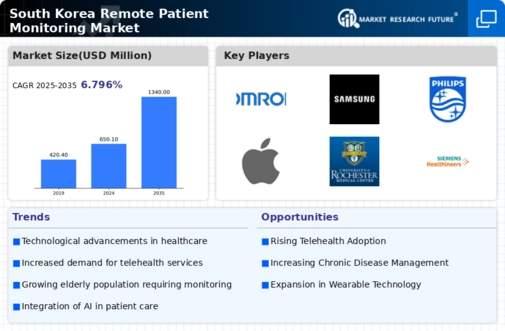The remote patient-monitoring market in South Korea is characterized by a dynamic competitive landscape, driven by technological advancements and an increasing demand for efficient healthcare solutions. Key players such as Philips (NL), Medtronic (US), and GE Healthcare (US) are at the forefront, each adopting distinct strategies to enhance their market presence. Philips (NL) focuses on innovation in telehealth solutions, aiming to integrate advanced analytics and AI into their monitoring systems. Meanwhile, Medtronic (US) emphasizes strategic partnerships with local healthcare providers to expand its reach and improve patient outcomes. GE Healthcare (US) is investing heavily in digital transformation, enhancing its remote monitoring capabilities through cloud-based platforms, which collectively shape a competitive environment that is increasingly reliant on technology and collaboration.
In terms of business tactics, companies are localizing manufacturing and optimizing supply chains to better serve the South Korean market. The competitive structure appears moderately fragmented, with several players vying for market share, yet the influence of major companies remains substantial. This fragmentation allows for innovation and diverse offerings, but also creates challenges in maintaining consistent quality and service levels across the board.
In October 2025, Philips (NL) announced a partnership with a leading South Korean hospital network to implement its latest remote monitoring technology, which is expected to enhance patient engagement and streamline care delivery. This strategic move underscores Philips' commitment to leveraging local expertise and resources, potentially positioning the company as a leader in the region's telehealth landscape. The collaboration is likely to facilitate the integration of advanced analytics into patient care, thereby improving health outcomes.
In September 2025, Medtronic (US) launched a new remote monitoring device specifically designed for chronic disease management, tailored to the needs of South Korean patients. This product introduction reflects Medtronic's strategy to address local healthcare challenges and demonstrates its focus on innovation. By aligning its offerings with regional health priorities, Medtronic may strengthen its competitive edge and enhance patient adherence to treatment protocols.
In August 2025, GE Healthcare (US) expanded its digital health platform to include advanced remote monitoring features, allowing healthcare providers to access real-time patient data. This enhancement is indicative of GE's strategy to lead in digital transformation within the healthcare sector. By providing comprehensive data analytics, GE Healthcare is likely to improve clinical decision-making and operational efficiency, further solidifying its position in the market.
As of November 2025, the competitive trends in the remote patient-monitoring market are increasingly defined by digitalization, sustainability, and the integration of AI technologies. Strategic alliances among key players are shaping the landscape, fostering innovation and enhancing service delivery. The shift from price-based competition to a focus on technological advancement and supply chain reliability is evident, suggesting that future competitive differentiation will hinge on the ability to innovate and adapt to evolving healthcare needs.




















Leave a Comment